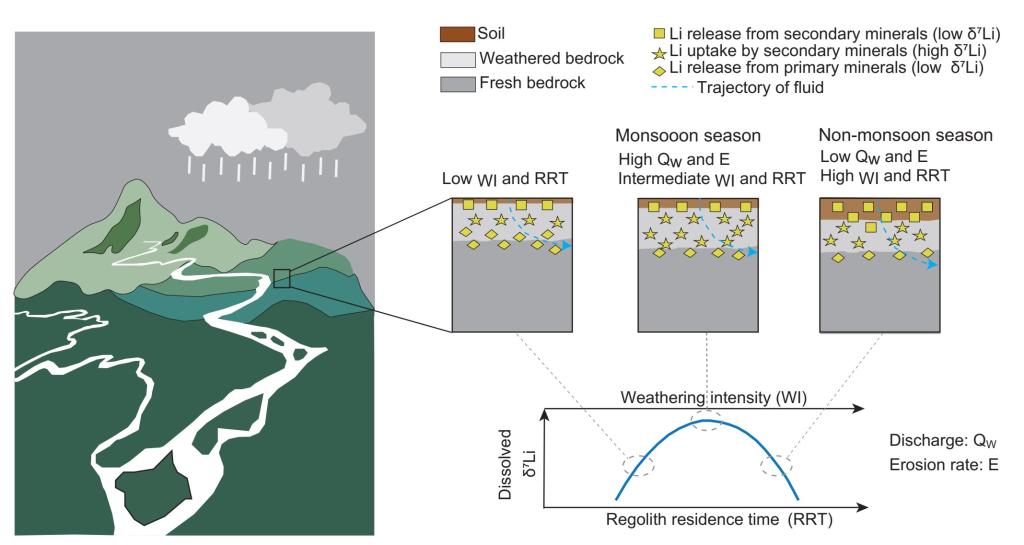To assess how chemical weathering processes in large high-relief river systems respond to climatic variability, we studied seasonal changes in radiogenic strontium (87Sr/86Sr) and stable calcium (δ44/40Ca), magnesium (δ26Mg), and lithium (δ7Li) isotopes in the Jinsha and Yalong rivers, which drain the southeastern Tibetan Plateau. During the low-runoff season, with discharge (Q) < 2000 m3/s, the river waters reflect the Sr, Ca, and Mg isotope signatures of recharge meltwaters, with additional isotope fractionation signals for Ca and Mg related to secondary mineral precipitation, which might imply that meltwater flushes soil solutions from the soil. During medium-runoff intervals (2000 m3/s < Q < 4000 m3/s), the Sr, Ca, and Mg isotope signatures in the Jinsha river waters are similar to those of the headwaters, which are influenced by evaporite dissolution, while the Yalong is affected by greater carbonate weathering relative to silicate weathering. In both rivers, bedrock dissolution governs the chemical composition of the river waters. During the high-runoff season (Q > 4000 m3/s), storms generate rapid overland flow, which transfers large volumes of soil into the rivers, such that soil weathering plays an important role in regulating riverine chemical compositions. At these times, the riverine Ca and Sr isotope evolution is influenced by secondary mineral dissolution and sediment-water cation exchange. The δ7Li values of the dissolved load exhibit a seasonal variation from +12.2‰ to +19.1‰, which reflects varying Li incorporation into secondary minerals during silicate weathering reactions. Dissolved δ7Li values in the non-monsoon season are low, which reflect the re-dissolution of secondary phases characterized by low Li isotopic composition, because the limited precipitation suppresses the supply of fresh minerals and hinders the formation of clay minerals and soils. In the monsoon season, as water discharge increases, dissolved δ7Li values increase with increasing silicate weathering and physical erosion rates. Variations in hydrological parameters (discharge) result in changes in the silicate weathering processes and related Li uptake by secondary minerals as the weathering regime switches from supply to kinetically limited conditions. Overall, this study highlights the potential of combining multiple isotope systems (Sr, Ca, Mg, Li) to trace the dynamics of water-rock interaction under variable hydrological conditions.
This research is co-supported financially by the National Natural Science Foundation of China (Grant No. 41925002), the 2nd Tibetan Plateau Scientific Expedition and Research (2019QZKK0707), and the Tianjin Science Fund for Distinguished Young Scholars (No. 18JCJQJC46200).

Fig.1 Schematic illustration of water sources and flow paths for the Jinsha and Yalong river basins during (a,b) the dry season with low runoff, (c,d) the intermediate runoff period, and (e,f) the wet season with high runoff

Fig.2 A conceptual diagram linking regolith residence time and weathering intensity to dissolved δ7Li signatures
Article information:
Bei-Bei Chen, Si-Liang Li*, Pogge von Strandmann, P.A.E., Wilson, D.J., Jun Zhong, Tingting Ma, Jian Sun, Cong-Qiang Liu. Behaviour of Sr, Ca, and Mg isotopes under variable hydrological conditions in high-relief large river systems. Geochimica et Cosmochimica Acta, 2023, 343, 142-160. https://doi.org/10.1016/j.gca.2023.01.003
Tingting Ma, Marc Weynell, Si-Liang Li*, Jun Zhong, Sen Xu, Cong-Qiang Liu. High-temporal resolution of lithium isotopes in the Yangtze River headwater: Hydrological control on weathering in high-relief catchments. Science of The Total Environment, 2023, 879, 163214. https://doi.org/10.1016/j.scitotenv.2023.163214
Bei-Bei Chen*, Si-Liang Li*, Pogge von Strandmann, P.A.E., Jun Zhong, Tingting Ma, Jian Sun, Wen-Yan He, Cong-Qiang Liu. Calcium isotopic geochemistry of geothermal systems in the tectonically active southeastern Tibetan Plateau. Science of The Total Environment, 2023, 867, 161534. https://doi.org/10.1016/j.scitotenv.2023.161534